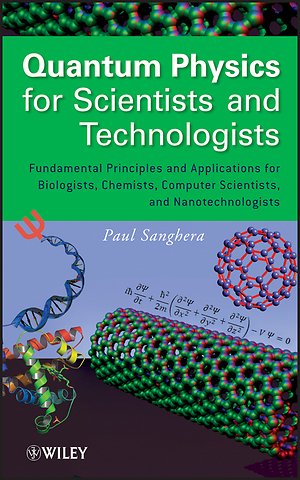Quantum Physics for Scientists and Technologists
Fundamental Principles and Applications for Biologists, Chemists, Computer Scientists, and Nanotechnologists
Gebonden Engels 2011 9780470294529Samenvatting
Quantum Physics for Scientists and Technologists is a self–contained, comprehensive review of this complex branch of science. The book demystifies difficult concepts and views the subject through non–physics fields such as computer science, biology, chemistry, and nanotechnology. It explains key concepts and phenomena in the language of non–physics majors and with simple math, assuming no prior knowledge of the topic.
This cohesive book begins with the wavefunction to develop the basic principles of quantum mechanics such as the uncertainty principle and wave–particle duality. Comprehensive coverage of quantum theory is presented, supported by experimental results and explained through applications and examples without the use of abstract and complex mathematical tools or formalisms. From there, the book:
Takes the mystery out of the Schrodinger equation, the fundamental equation of quantum physics, by applying it to atoms
Shows how quantum mechanics explains the periodic table of elements
Introduces the quantum mechanical concept of spin and spin quantum number, along with Pauli′s Exclusion Principle regarding the occupation of quantum states
Addresses quantum states of molecules in terms of rotation and vibration of diatomic molecules
Explores the interface between classical statistical mechanics and quantum statistical mechanics
Discusses quantum mechanics as a common thread through different fields of nanoscience and nanotechnology
Each chapter features real–world applications of one or more quantum mechanics principles. "Study Checkpoints" and problems with solutions are presented throughout to make difficult concepts easy to understand. In addition, pictures, tables, and diagrams with full explanations are used to present data and further explain difficult concepts.
This book is designed as a complete course in quantum mechanics for senior undergraduates and first–year graduate students in non–physics majors. It also applies to courses such as modern physics, physical chemistry and nanotechnology. The material is also accessible to scientists, engineers, and technologists working in the fields of computer science, biology, chemistry, engineering, and nanotechnology.
Specificaties
Lezersrecensies
Inhoudsopgave
<p>About the Author.</p>
<p>About the Tech Editor.</p>
<p>Periodic Table of the Elements.</p>
<p>Fundamental Physical Constants.</p>
<p>Important Combinations of Physical Constants.</p>
<p>Preface: Science, Technology, and Quantum Physics: Mind the Gap.</p>
<p>1 First, There Was Classical Physics.</p>
<p>1.1 Introduction.</p>
<p>1.2 Physics and Classical Physics.</p>
<p>1.3 The Classical World of Particles.</p>
<p>1.4 Physical Quantities.</p>
<p>1.5 Newton′s Laws of Motion.</p>
<p>1.6 Rotational Motion.</p>
<p>1.7 Superposition and Collision of Particles.</p>
<p>1.8 Classical World of Waves.</p>
<p>1.9 Refl ection, Refraction, and Scattering.</p>
<p>1.10 Diffraction and Interference.</p>
<p>1.11 Equation of Wave Motion.</p>
<p>1.12 Light: Particle or Wave?</p>
<p>1.13 Understanding Electricity.</p>
<p>1.14 Understanding Magnetism.</p>
<p>1.15 Understanding Electromagnetism.</p>
<p>1.16 Maxwell′s Equations.</p>
<p>1.17 Confi nement, Standing Waves, and Wavegroups.</p>
<p>1.18 Particles and Waves: The Big Picture.</p>
<p>1.19 The Four Fundamental Forces of Nature.</p>
<p>1.20 Unification: A Secret to Scientific and Technological Revolutions.</p>
<p>1.21 Special Theory of Relativity.</p>
<p>1.22 Classical Approach.</p>
<p>1.23 Summary.</p>
<p>1.24 Additional Problems.</p>
<p>2 Particle Behavior of Waves.</p>
<p>2.1 Introduction.</p>
<p>2.2 The Nature of Light: The Big Picture.</p>
<p>2.3 Black–Body Radiation.</p>
<p>2.4 The Photoelectric Effect.</p>
<p>2.5 X–Ray Diffraction.</p>
<p>2.6 The Compton Effect.</p>
<p>2.7 Living in the Quantum World.</p>
<p>2.8 Summary.</p>
<p>2.9 Additional Problems.</p>
<p>3 Wave Behavior of Particles.</p>
<p>3.1 Introduction.</p>
<p>3.2 Particles and Waves: The Big Picture.</p>
<p>3.3 The de Broglie Hypothesis.</p>
<p>3.4 Measuring the Wavelength of Electrons.</p>
<p>3.5 Quantum Confi nement.</p>
<p>3.6 The Uncertainty Principle.</p>
<p>3.7 Wave–Particle Duality of Nature.</p>
<p>3.8 Living in the Quantum World.</p>
<p>3.9 Summary.</p>
<p>3.10 Additional Problems.</p>
<p>4 Anatomy of an Atom.</p>
<p>4.1 Introduction.</p>
<p>4.2 Quantum Mechanics of an Atom: The Big Picture.</p>
<p>4.3 Dalton′s Atomic Theory.</p>
<p>4.4 The Structure of an Atom.</p>
<p>4.5 The Classical Collapse of an Atom.</p>
<p>4.6 The Quantum Rescue.</p>
<p>4.7 Quantum Mechanics of an Atomic Structure.</p>
<p>4.8 Classical Physics or Quantum Physics: Which One Is the True Physics?</p>
<p>4.9 Living in the Quantum World.</p>
<p>4.10 Summary.</p>
<p>4.11 Additional Problems.</p>
<p>5 Principles and Formalism of Quantum Mechanics.</p>
<p>5.1 Introduction.</p>
<p>5.2 Here Comes Quantum Mechanics.</p>
<p>5.3 Wave Function: The Basic Building Block of Quantum Mechanics.</p>
<p>5.4 Operators: The Information Extractors.</p>
<p>5.5 Predicting the Measurements.</p>
<p>5.6 Put It All into an Equation.</p>
<p>5.7 Eigenfunctions and Eigenvalues.</p>
<p>5.8 Double Slit Experiment Revisited.</p>
<p>5.9 The Quantum Reality.</p>
<p>5.10 Living in the Quantum World.</p>
<p>5.11 Summary.</p>
<p>5.12 Additional Problems.</p>
<p>6 The Anatomy and Physiology of an Equation.</p>
<p>6.1 Introduction.</p>
<p>6.2 The Schrödinger Wave Equation.</p>
<p>6.3 The Schrödinger Equation for a Free Particle.</p>
<p>6.4 Schrödinger Equation for a Particle in a Box.</p>
<p>6.5 A Particle in a Three–Dimensional Box.</p>
<p>6.6 Harmonic Oscillator.</p>
<p>6.7 Understanding the Wave Functions of a Harmonic Oscillator.</p>
<p>6.8 Comparing Quantum Mechanical Oscillator with Classical Oscillator.</p>
<p>6.9 Living in the Quantum World.</p>
<p>6.10 Summary.</p>
<p>6.11 Additional Problems. </p>
<p>7 Quantum Mechanics of an Atom.</p>
<p>7.1 Introduction.</p>
<p>7.2 Applying the Schrödinger Equation to the Hydrogen Atom.</p>
<p>7.3 Solving the Schrödinger Equation for the Hydrogen Atom.</p>
<p>7.4 Finding the Electron.</p>
<p>7.5 Understanding the Quantum Numbers.</p>
<p>7.6 The Signifi cance of Hydrogen.</p>
<p>7.7 Living in the Quantum World.</p>
<p>7.8 Summary.</p>
<p>7.9 Additional Problems.</p>
<p>8 Quantum Mechanics of Many–Electron Atoms.</p>
<p>8.1 Introduction.</p>
<p>8.2 Two Challenges to Quantum Mechanics: The Periodic Table and the Zeeman Effect.</p>
<p>8.3 Introducing the Electron Spin.</p>
<p>8.4 Exclusion Principle.</p>
<p>8.5 Understanding the Atomic Structure.</p>
<p>8.6 Understanding the Physical Basis of the Periodic Table.</p>
<p>8.7 Completing the Story of Angular Momentum.</p>
<p>8.8 Understanding the Zeeman Effect.</p>
<p>8.9 Living in the Quantum World.</p>
<p>8.10 Summary.</p>
<p>8.11 Additional Problems.</p>
<p>9 Quantum Mechanics of Molecules.</p>
<p>9.1 Introduction.</p>
<p>9.2 A System of Molecules in Motion.</p>
<p>9.3 Bond: The Atomic Bond.</p>
<p>9.4 Diatomic Molecules.</p>
<p>9.5 Rotational States of Molecules.</p>
<p>9.6 Vibrational States of Molecules.</p>
<p>9.7 Combination of Rotations and Vibrations.</p>
<p>9.8 Electronic States of Molecules.</p>
<p>9.9 Living in the Quantum World.</p>
<p>9.10 Summary.</p>
<p>9.11 Additional Problems.</p>
<p>10 Statistical Quantum Mechanics.</p>
<p>10.1 Introduction.</p>
<p>10.2 Statistical Distributions.</p>
<p>10.3 Maxwell Boltzmann Distribution.</p>
<p>10.4 Molecular Systems with Quantum States.</p>
<p>10.5 Distribution of Vibrational Energies.</p>
<p>10.6 Distribution of Rotational Energies.</p>
<p>10.7 Distribution of Translational Energies.</p>
<p>10.8 Quantum Statistics of Distinguishable Particles: Putting It All Together.</p>
<p>10.9 Quantum Statistics of Indistinguishable Particles.</p>
<p>10.10 Planck s Radiation Formula.</p>
<p>10.11 Absorption, Emission, and Lasers.</p>
<p>10.12 Bose Einstein Condensation.</p>
<p>10.13 Living in the Quantum World.</p>
<p>10.14 Summary.</p>
<p>10.15 Additional Problems.</p>
<p>11 Quantum Mechanics: A Thread Runs through It all.</p>
<p>11.1 Introduction.</p>
<p>11.2 Nanoscience and Nanotechnology.</p>
<p>11.3 Nanoscale Quantum Confi nement of Matter.</p>
<p>11.4 Quick Overview of Microelectronics.</p>
<p>11.5 Quantum Computing.</p>
<p>11.6 Quantum Biology.</p>
<p>11.7 Exploring the Interface of Classical Mechanics and Quantum Mechanics.</p>
<p>11.8 Living in the Quantum World.</p>
<p>11.9 Summary.</p>
<p>11.10 Additional Problems.</p>
<p>Bibliography.</p>
<p>Index.</p>
Rubrieken
- advisering
- algemeen management
- coaching en trainen
- communicatie en media
- economie
- financieel management
- inkoop en logistiek
- internet en social media
- it-management / ict
- juridisch
- leiderschap
- marketing
- mens en maatschappij
- non-profit
- ondernemen
- organisatiekunde
- personal finance
- personeelsmanagement
- persoonlijke effectiviteit
- projectmanagement
- psychologie
- reclame en verkoop
- strategisch management
- verandermanagement
- werk en loopbaan

